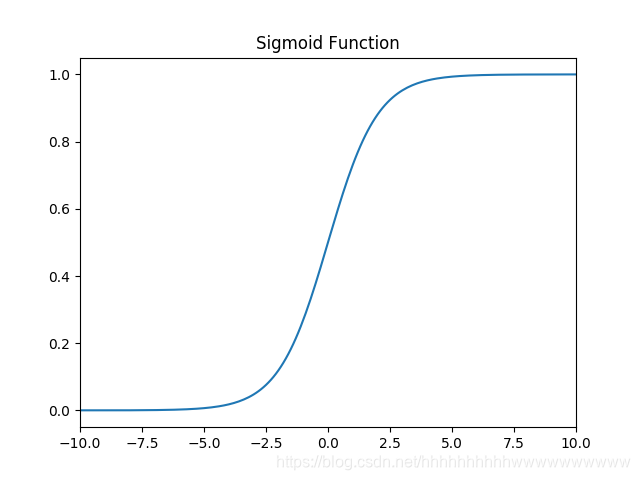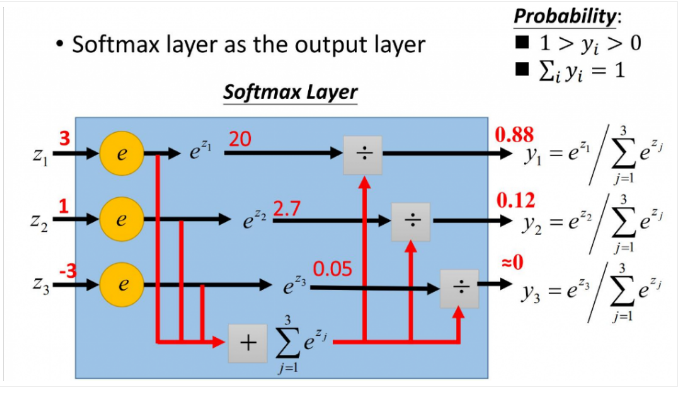@[toc]
1、激活函数的实现
1.1 sigmoid
1.1.1 函数
函数:
f(x)=1+e−x1

1.1.2 导数
求导过程:
根据:
(vu)′=v2u′v−uv′
f(x)′=(1+e−x1)′=(1+e−x)21′×(1+e−x)−1×(1+e−x)′=(1+e−x)2e−x=(1+e−x)21+e−x−1=(1+e−x1)(1−1+e−x1)=f(x)(1−f(x))

1.1.3 代码实现
import numpy as np
class Sigmoid():
def __call__(self, x):
return 1 / (1 + np.exp(-x))
def gradient(self, x):
return self.__call__(x) * (1 - self.__call__(x))
1.2 softmax
1.2.1 函数
softmax用于多分类过程中,它将多个神经元的输出,映射到(0,1)区间内,可以看成概率来理解,从而来进行多分类!
假设我们有一个数组,V,Vi表示V中的第i个元素,那么这个元素的softmax值就是:
Si=∑jejei
更形象的如下图表示:

y1=ez1+ez2+ez3ez1y2=ez1+ez2+ez3ez2y3=ez1+ez2+ez3ez3(1)
要使用梯度下降,就需要一个损失函数,一般使用交叉熵作为损失函数,交叉熵函数形式如下:
Loss=−i∑yilnai(2)
1.2.2 导数
求导分为两种情况。
第一种j=i:
Si=∑jejei=∑ieiei
推导过程如下:
f′=(∑ieiei)′=(∑iei)2(ei)×∑iei−ei×ei=∑ieiei−∑ieiei×∑ieiei=∑ieiei(1−∑ieiei)=f(1−f)
1.2.3 代码实现
import numpy as np
class Softmax():
def __call__(self, x):
e_x = np.exp(x - np.max(x, axis=-1, keepdims=True))
return e_x / np.sum(e_x, axis=-1, keepdims=True)
def gradient(self, x):
p = self.__call__(x)
return p * (1 - p)
1.3 tanh
1.3.1 函数
tanh(x)=ex+e−xex−e−x

1.3.2 导数
求导过程:
tanh(x)′=(ex+e−xex−e−x)′=(ex+e−x)2(ex−e−x)′(ex+e−x)−(ex−e−x)(ex+e−x)′=(ex+e−x)2(ex+e−x)2−(ex⋅e−x)2=1−(ex+e−xex−e−x)2=1−tanh(x)2
1.3.3 代码实现
import numpy as np
class TanH():
def __call__(self, x):
return 2 / (1 + np.exp(-2*x)) - 1
def gradient(self, x):
return 1 - np.power(self.__call__(x), 2)
1.4 relu
1.4.1 函数
f(x)=max(0,x)
1.4.2 导数
f′(x)={10 if (x>0) if (x<=0)
1.4.3 代码实现
import numpy as np
class ReLU():
def __call__(self, x):
return np.where(x >= 0, x, 0)
def gradient(self, x):
return np.where(x >= 0, 1, 0)
1.5 leakyrelu
1.5.1 函数
f(x)=max(ax,x)
1.5.2 导数
f′(x)={1a if (x>0) if (x<=0)
1.5.3 代码实现
import numpy as np
class LeakyReLU():
def __init__(self, alpha=0.2):
self.alpha = alpha
def __call__(self, x):
return np.where(x >= 0, x, self.alpha * x)
def gradient(self, x):
return np.where(x >= 0, 1, self.alpha)
1.6 ELU
1.61 函数
f(x)={x,a(ex−1), if x≥0 if (x<0)
1.6.2 导数
当x>=0时,导数为1。
当x<0时,导数的推导过程:
f(x)′=(a(ex−1))′=aex=a(ex−1)+a=f(x)+a=aex
所以,完整的导数为:
f′={1f(x)+a=aex if if x≥0x<0
1.6.3 代码实现
import numpy as np
class ELU():
def __init__(self, alpha=0.1):
self.alpha = alpha
def __call__(self, x):
return np.where(x >= 0.0, x, self.alpha * (np.exp(x) - 1))
def gradient(self, x):
return np.where(x >= 0.0, 1, self.__call__(x) + self.alpha)
1.7 selu
1.7.1 函数
selu(x)=λ{xαex−α if (x>0) if (x⩽0)
1.7.2 导数
selu′(x)=λ{1αexx>0⩽0
1.7.3 代码实现
import numpy as np
class SELU():
def __init__(self):
self.alpha = 1.6732632423543772848170429916717
self.scale = 1.0507009873554804934193349852946
def __call__(self, x):
return self.scale * np.where(x >= 0.0, x, self.alpha*(np.exp(x)-1))
def gradient(self, x):
return self.scale * np.where(x >= 0.0, 1, self.alpha * np.exp(x))
1.8 softplus
1.81 函数
Softplus(x)=log(1+ex)
1.8.2 导数
log默认的底数是
e
f′(x)=(1+ex)lneex=1+e−x1=σ(x)
1.8.3 代码实现
import numpy as np
class SoftPlus():
def __call__(self, x):
return np.log(1 + np.exp(x))
def gradient(self, x):
return 1 / (1 + np.exp(-x))
1.9 Swish
1.9.1 函数
f(x)=x⋅sigmoid(βx)
1.9.2 导数
f′(x)=σ(βx)+βx⋅σ(βx)(1−σ(βx))=σ(βx)+βx⋅σ(βx)−βx⋅σ(βx)2=βx⋅σ(x)+σ(βx)(1−βx⋅σ(βx))=βf(x)+σ(βx)(1−βf(x))
1.9.3 代码实现
import numpy as np
class Swish(object):
def __init__(self, b):
self.b = b
def __call__(self, x):
return x * (np.exp(self.b * x) / (np.exp(self.b * x) + 1))
def gradient(self, x):
return self.b * x / (1 + np.exp(-self.b * x)) + (1 / (1 + np.exp(-self.b * x)))(
1 - self.b * (x / (1 + np.exp(-self.b * x))))
1.10 Mish
1.10.1 函数
f(x)=x∗tanh(ln(1+ex))
1.10.2 导数
f′(x)=sech2(softplus(x))xsigmoid(x)+xf(x)=Δ(x)swish(x)+xf(x)
where softplus
(x)=ln(1+ex) and sigmoid
(x)=1/(1+e−x).
1.10.3 代码实现
import numpy as np
def sech(x):
"""sech函数"""
return 2 / (np.exp(x) + np.exp(-x))
def sigmoid(x):
"""sigmoid函数"""
return 1 / (1 + np.exp(-x))
def soft_plus(x):
"""softplus函数"""
return np.log(1 + np.exp(x))
def tan_h(x):
"""tanh函数"""
return (np.exp(x) - np.exp(-x)) / (np.exp(x) + np.exp(-x))
class Mish:
def __call__(self, x):
return x * tan_h(soft_plus(x))
def gradient(self, x):
return sech(soft_plus(x)) * sech(soft_plus(x)) * x * sigmoid(x) + tan_h(soft_plus(x))
1.11 SiLU
1.11.1 函数
f(x)=x×sigmoid(x)

1.11.2 导数
推导过程
f(x)′=(x⋅sigmoid(x))′=sigmoid(x)+x⋅(sigmoid(x)(1−sigmoid(x))=sigmoid(x)+x⋅sigmoid(x)−x⋅sigmoid2(x)=f(x)+sigmoid(x)(1−f(x))

1.11.3 代码实现
import numpy as np
def sigmoid(x):
"""sigmoid函数"""
return 1 / (1 + np.exp(-x))
class SILU(object):
def __call__(self, x):
return x * sigmoid(x)
def gradient(self, x):
return self.__call__(x) + sigmoid(x) * (1 - self.__call__(x))
1.12 完整代码
定义一个activation_function.py,将下面的代码复制进去,到这里激活函数就完成了。
import numpy as np
class Sigmoid():
def __call__(self, x):
return 1 / (1 + np.exp(-x))
def gradient(self, x):
return self.__call__(x) * (1 - self.__call__(x))
class Softmax():
def __call__(self, x):
e_x = np.exp(x - np.max(x, axis=-1, keepdims=True))
return e_x / np.sum(e_x, axis=-1, keepdims=True)
def gradient(self, x):
p = self.__call__(x)
return p * (1 - p)
class TanH():
def __call__(self, x):
return 2 / (1 + np.exp(-2 * x)) - 1
def gradient(self, x):
return 1 - np.power(self.__call__(x), 2)
class ReLU():
def __call__(self, x):
return np.where(x >= 0, x, 0)
def gradient(self, x):
return np.where(x >= 0, 1, 0)
class LeakyReLU():
def __init__(self, alpha=0.2):
self.alpha = alpha
def __call__(self, x):
return np.where(x >= 0, x, self.alpha * x)
def gradient(self, x):
return np.where(x >= 0, 1, self.alpha)
class ELU(object):
def __init__(self, alpha=0.1):
self.alpha = alpha
def __call__(self, x):
return np.where(x >= 0.0, x, self.alpha * (np.exp(x) - 1))
def gradient(self, x):
return np.where(x >= 0.0, 1, self.__call__(x) + self.alpha)
class SELU():
def __init__(self):
self.alpha = 1.6732632423543772848170429916717
self.scale = 1.0507009873554804934193349852946
def __call__(self, x):
return self.scale * np.where(x >= 0.0, x, self.alpha * (np.exp(x) - 1))
def gradient(self, x):
return self.scale * np.where(x >= 0.0, 1, self.alpha * np.exp(x))
class SoftPlus(object):
def __call__(self, x):
return np.log(1 + np.exp(x))
def gradient(self, x):
return 1 / (1 + np.exp(-x))
class Swish(object):
def __init__(self, b):
self.b = b
def __call__(self, x):
return x * (np.exp(self.b * x) / (np.exp(self.b * x) + 1))
def gradient(self, x):
return self.b * x / (1 + np.exp(-self.b * x)) + (1 / (1 + np.exp(-self.b * x)))(
1 - self.b * (x / (1 + np.exp(-self.b * x))))
def sech(x):
"""sech函数"""
return 2 / (np.exp(x) + np.exp(-x))
def sigmoid(x):
"""sigmoid函数"""
return 1 / (1 + np.exp(-x))
def soft_plus(x):
"""softplus函数"""
return np.log(1 + np.exp(x))
def tan_h(x):
"""tanh函数"""
return (np.exp(x) - np.exp(-x)) / (np.exp(x) + np.exp(-x))
class Mish:
def __call__(self, x):
return x * tan_h(soft_plus(x))
def gradient(self, x):
return sech(soft_plus(x)) * sech(soft_plus(x)) * x * sigmoid(x) + tan_h(soft_plus(x))
class SILU(object):
def __call__(self, x):
return x * sigmoid(x)
def gradient(self, x):
return self.__call__(x) + sigmoid(x) * (1 - self.__call__(x))
参考公式
(C)′=0
(ax)′=axlna
(xμ)′=μxμ−1
(ex)′=ex
(sinx)′=cosx
(logax)′=xlna1
(cosx)′=−sinx
(lnx)′=x1
(tanx)′=sec2x
(arcsinx)′=1−x2
1
(cotx)′=−csc2x
(arccosx)′=−1−x2
1
(secx)′=secx⋅tanx
(arctanx)′=1+x21
(cscx)′=−cscx⋅cotx
(arccotx)′=−1+x21
双曲正弦:
sinhx=2ex−e−x
双曲余弦:
coshx=2ex+e−x
双曲正切:
tanhx=coshxsinhx=ex+e−xex−e−x
双曲余切:
cothx=tanhx1=ex−e−xex+e−x
双曲正割:
sechx=coshx1=ex+e−x2
双曲余割:
cschx=sinhx1=ex−e−x2








评论(0)